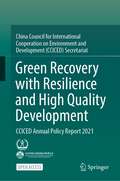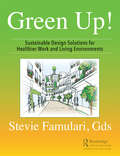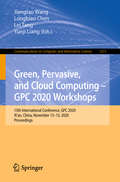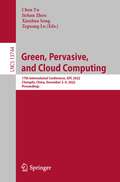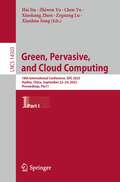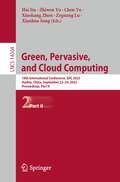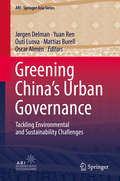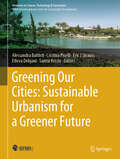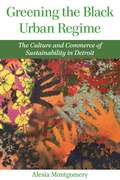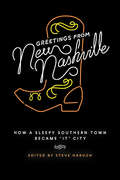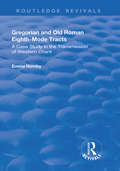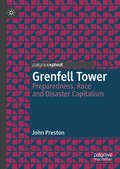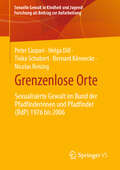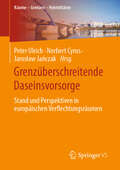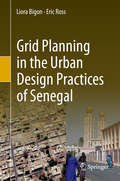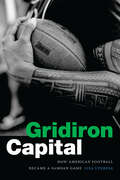- Table View
- List View
Green Recovery with Resilience and High Quality Development: CCICED Annual Policy Report 2021
by CCICEDThis open access book is based on the research outputs of China Council for International Cooperation on Environment and Development (CCICED) in 2021. It covers major topics of Chinese and international attention regarding green development, such as climate, biodiversity, ocean, BRI, urbanization, sustainable production and consumption, technology, finance, value chain, and related topics. It also reviews the progress of China‘s environmental and development policies and the impacts from CCICED. This is a highly informative and carefully presented book, providing insight for policy makers in environmental issues.
Green This! Greening Your Cleaning
by Deirdre ImusChange the way you clean and keep your family's home wholesome and healthy with the help of expert and activist Deirdre Imus. As Deirdre Imus reveals, some of the chemicals we use to maintain our homes are doing our families much more harm than good.
Green Up!: Sustainable Design Solutions for Healthier Work and Living Environments
by Stevie FamulariThere are unique greening solutions and practices that help create a lifestyle shift, improving the health of living and working spaces for its occupants from a personal, business, environmental, and profitable perspective. Short-term and long-term considerations are important elements when moving forward towards healthy practices in lifestyles, choices, and site designs. This book addresses a myriad of greening practices that can be applied to structures in our urban, suburban, and rural cultures. From the loft to the neighborhood, the office spaces to the public spaces, and the schools to the communities, this book outlines how business owners and residents can integrate scale appropriate green solutions into their lifestyles. Green Up!: Sustainable Design Solutions for Healthier Work and Living Environments includes detailed illustrations and photographs to help you understand design opportunities for your space. Stevie Famulari provides unique insights and inspires business owners, residents, and planners to develop their own green understanding and design solutions. Illustrations and photographs of applied greening are included throughout the book to help inspire your own goals and design, and then transform them to reality. The author breaks down the misconceptions of the complexity of sustainability and green practices. Greening is a lifestyle change, and this step-by-step instruction guide lets you know how easy it is to transition to the green side!
Green Village and Town Construction in China
by Xiaoming Wang Hong HuaBy means of multidisciplinary research on urban and rural planning, construction engineering, environmental engineering and engineering sociology, this book conducts pioneering research on the construction theory, construction methods, evaluation technology and application of demonstration projects in China’s green villages and towns. The book is divided into three parts and eleven chapters. Part I is about the theory and development of green village and town construction, including the theory and innovation, the evolution and development, the patterns and mechanisms, and the community of green village and town construction. Part II is about the planning and construction methods of green villages and towns, including the plan compilation, the environmental infrastructure construction, and the construction and renovation of green buildings in villages and towns. Part III is about the evaluation of the planning and construction of green villages and towns, including the evaluation of plans, the evaluation of environmental infrastructure construction, the evaluation of green building construction, and the comprehensive evaluation of the planning and construction of green villages and towns. Today, 564 million farmers live in 28,500 towns and 2.452 million villages in China. In 2018 alone, 820 million m2 of new houses were built in rural areas. This proves that China’s green village and town construction has great significance and can provide enlightenment to developing countries and even to the world. The book describes new theories, new perspectives and new methods of green village and town sustainable construction in China for overseas experts and readers.
Green Washed
by Kendra Pierre-LouisThe message that our environment is in peril has filtered from environmental groups to theAmerican consciousness to our shopping carts. Every day, millions of Americans dutifully replace conventional produce with organic, swap Mr. Clean for Seventh Generation, and replace their bottled water with water bottles. Many of us have come to believe that the path to environmental sustainability is paved by shopping green. Although this green consumer movement certainly has many Americans consuming differently, it raises an important and rarely asked question--"is this consumption really any better for the planet?" By examining the major economic sectors of our society, including infrastructure (green housing), consumer goods (green clothing and jewelry), food (the rise of organic), and energy (including solar power and the popularity of the hybrid car), Green Washed: Why We Can't Buy Our Way to a Green Planet explains that, though greener alternatives are important, we cannot simply buy our way to sustainability. Rather, if it is the volume of our consumption that matters, can we as a society dependent on constantly consuming ever be content with buying less? A new and unique take on green consumption, Green Washed shows how buying better is only the first step toward true sustainability. Kendra Pierre-Louis is the sustainable development editor for Justmeans.com. She holds a master's degree in sustainable development from the SIT Graduate Institute in Vermont. She has created outreach material for the United Nations Environment Programme's Convention on Biological Diversity and worked as a researcher for Terrapin Bright Green, an environmental consulting and strategic planning firm.
Green Your Work
by Kim CarlsonToday, many companies are flourishing by delivering high-quality products while pursuing policies that leave the world a cleaner, better place. Those policies can help retain customers, energize employees, and serve as brand-building tools. This book shows managers practical steps to make their companies environmentally responsible while staying profitable and efficient. Environmentalist and businesswoman Kim Carlson shows managers how to green company operations by moving to a paperless office, recycling at work, setting up employee carpools, developing eco-friendly packaging, using green building products, and more. She explains in detail topics ranging from green marketing to setting up a carbon footprint assessment for the company. With this book at their side, managers can turn green into profits.
Green Your Work: Boost Your Bottom Line While Reducing Your Carbon Footprint
by Kim CarlsonToday, many companies are flourishing by delivering high-quality products while pursuing policies that leave the world a cleaner, better place. Those policies can help retain customers, energize employees, and serve as brand-building tools. This book shows managers practical steps to make their companies environmentally responsible while staying profitable and efficient. Environmentalist and businesswoman Kim Carlson shows managers how to green company operations by moving to a paperless office, recycling at work, setting up employee carpools, developing eco-friendly packaging, using green building products, and more. She explains in detail topics ranging from green marketing to setting up a carbon footprint assessment for the company. With this book at their side, managers can turn green into profits.
Green, Pervasive, and Cloud Computing – GPC 2020 Workshops: 15th International Conference, GPC 2020, Xi'an, China, November 13–15, 2020, Proceedings (Communications in Computer and Information Science #1311)
by Jiangtao Wang Longbiao Chen Lei Tang Yunji LiangThis book constitutes the refereed proceedings of the Workshops from the 15th International Conference on Green, Pervasive, and Cloud Computing, GPC 2020, held in Xi'an, China, in November 2020. Due to the COVID-19 pandemic this event was held virtually.The 5 full papers presented in this book together with 3 short papers were carefully reviewed and selected from 16 submissions. They present recent research in the areas of urban computing, intelligent transportation and social computing.
Green, Pervasive, and Cloud Computing: 17th International Conference, GPC 2022, Chengdu, China, December 2–4, 2022, Proceedings (Lecture Notes in Computer Science #13744)
by Xianhua Song Zeguang Lu Chen Yu Jiehan ZhouThis book constitutes the refereed proceedings of the 17th International Conference on Green, Pervasive, and Cloud Computing, GPC 2022, held in Chengdu, China, in December 2022.The 19 full papers presented in this book were carefully reviewed and selected from 104 submissions. GPC 2022 shares novel ideas and experiences in the areas of Green, Pervasive, and Cloud Computing.
Green, Pervasive, and Cloud Computing: 18th International Conference, GPC 2023, Harbin, China, September 22–24, 2023, Proceedings, Part I (Lecture Notes in Computer Science #14503)
by Xianhua Song Zeguang Lu Hai Jin Chen Yu Zhiwen Yu Xiaokang ZhouThis book constitutes the refereed proceedings of the 18th International Conference on Green, Pervasive, and Cloud Computing, GPC 2023, held in Harbin, China, during September 23–24, 2023.The 38 full papers and 1 short paper included in this book were carefully reviewed and selected from 111 submissions. They were organized in topical sections as follows: Industrial Digitization and Applications, Edge Intelligence, Mobile Sensing and Computing, Cyber-Physical-Social Systems, Pervasive and Green Computing and Wireless and Ubiquitous Networking.
Green, Pervasive, and Cloud Computing: 18th International Conference, GPC 2023, Harbin, China, September 22–24, 2023, Proceedings; Part II (Lecture Notes in Computer Science #14504)
by Xianhua Song Zeguang Lu Hai Jin Chen Yu Zhiwen Yu Xiaokang ZhouThis book constitutes the refereed proceedings of the 18th International Conference on Green, Pervasive, and Cloud Computing, GPC 2023, held in Harbin, China, during September 23–24, 2023.The 38 full papers and 1 short paper included in this book were carefully reviewed and selected from 111 submissions. They were organized in topical sections as follows: Industrial Digitization and Applications, Edge Intelligence, Mobile Sensing and Computing, Cyber-Physical-Social Systems, Pervasive and Green Computing and Wireless and Ubiquitous Networking.
Greening China’s Urban Governance: Tackling Environmental and Sustainability Challenges (ARI - Springer Asia Series #7)
by Jørgen Delman Yuan Ren Outi Luova Mattias Burell Oscar AlménThis volume examines how urban stakeholders in China – particularly city governments and social actors – tackle China’s urban environmental crisis. The volume’s case studies speak to important interdisciplinary themes such as new tools and instruments of urban green governance, climate change and urban carbon consumption, green justice, digital governance, public participation, social media, social movements, and popular protest. It lays out a unique theoretical framework for examining and discussing urban green governance. The case studies are based on extensive fieldwork that examines governance failures, challenges, and innovations from across China, including the largest cities. They show that numerous policies, experiments, and reforms have been put in place in China – mostly on a pragmatic basis, but also as a result of both strategic policy design, civil participation, and protest. The book highlights how China’s urban governments bring together diverse programmatic building blocks and instruments, from China and elsewhere. Written by experts and researchers from different disciplines at leading universities in China and the Nordic countries in Europe, this volume will be of interest to researchers and students who are interested in Chinese politics, especially urban politics, governance issues, and social movements. Both students and teachers will find the theoretical perspectives and case studies useful in their coursework.The unique green governance perspective makes this a work that is empirically and theoretically interesting for those working with urban political and environmental studies and urbanization worldwide.
Greening Our Cities: A Culmination of Selected Research Papers from the International Conferences on Green Urbanism (GU) – 6th edition and Urban Regeneration and Sustainability (URS) – 2022 (Advances in Science, Technology & Innovation)
by Alessandra Battisti Cristina Piselli Eric J Strauss Etleva Dobjani Saimir KristoThis thought-provoking book takes readers on a captivating journey through the realms of green urbanism, urban regeneration, and urban design, development, and preservation, providing an exploration of innovative approaches to creating sustainable and thriving cities of the future.Discussing the pressing challenges of urban environments, this book offers practical insights for architects, urban planners, researchers, and sustainability enthusiasts. It introduces cutting-edge strategies for sustainable urban mobility, energy-efficient designs, and nature-based solutions implementation while showcasing case studies and comprehensive analyses that shed light on the complexities of urban regeneration. Moreover, this volume uncovers the importance of preserving cultural heritage and its role in shaping vibrant communities. With its informative and engaging narrative, this book equips readers with valuable knowledge to make a positive impact on their urban surroundings. It deepens their understanding of urban challenges and illuminates ways they can contribute to transforming our cities toward a more sustainable and vibrant future.
Greening the Black Urban Regime: The Culture and Commerce of Sustainability in Detroit (Great Lakes Books Series)
by Alesia MontgomeryAlesia Montgomery’s Greening the Black Urban Regime: The Culture and Commerce of Sustainability in Detroit tells the story of the struggle to shape green redevelopment in Detroit. Cultural workers, envisioning a green city crafted by direct democracy, had begun to draw idealistic young newcomers to Detroit’s street art and gardens. Then a billionaire developer and private foundations hired international consultants to redesign downtown and to devise a city plan. Using the justice-speak of cultural workers, these consultants did innovative outreach, but they did not enable democratic deliberation. The Detroit Future City plan won awards, and the new green venues in the gentrified downtown have gotten good press. However, low-income black Detroiters have little ability to shape "greening" as uneven development unfolds and poverty persists. Based on years of fieldwork, Montgomery takes us into the city council chambers, nonprofit offices, gardens, churches, cafés, street parties, and public protests where the future of Detroit was imagined, debated, and dictated. She begins by using statistical data and oral histories to trace the impacts of capital flight, and then she draws on interviews and observations to show how these impacts influence city planning. Hostility between blacks and whites shape the main narrative, yet indigenous, Asian, Arab, and Latinx peoples in Detroit add to the conflict. Montgomery compares Detroit to other historical black urban regimes (HBURs)—U.S. cities that elected their first black mayors soon after the 1960s civil rights movement. Critiques of ecological urbanism in HBURs typically focus on gentrification. In contrast, Montgomery identifies the danger as minoritization: the imposition of "beneficent" governance across gentrified and non-gentrified neighborhoods that treats the black urban poor as children of nature who lack the (mental, material) capacities to decide their future. Scholars and students in the social sciences, as well as general readers with social and environmental justice concerns, will find great value in this research.
Greening the Globe
by Ann HironakaRecent decades have seen a rapid expansion of environmental activity in the world, including the signing of a growing number of environmental treaties and the formation of international organizations like the United Nations Environment Programme (UNEP). Greening the Globe employs world society theory (aka world polity theory or sociological institutionalism) to explore the origins and consequences of international efforts to address environmental problems. Existing scholarship seems paradoxical: case studies frequently criticize treaties and regulatory structures as weak and ineffective, yet statistical studies find improvements in environmental conditions. This book addresses this paradox by articulating a bee-swarm model of social change. International institutions rarely command the power or resources to directly impose social change. Nevertheless, they have recourse via indirect mechanisms: setting agendas, creating workspaces where problems can be addressed, empowering various pro-environmental agents, and propagating new cultural meanings and norms. As a result, world society generates social change even if formal institutional mechanisms and sanctions are weak.
Greentopia: Towards a Sustainable Toronto (uTOpia)
by Jonny Dovercourt Alana WilcoxGardening the Gardiner. Hydrogen-fuelled cabs. Rooftop Power. Rainwater harvesting. A new model of taxation. The art of salvage. Drinking less coffee. Composters for dog poo in city parks. Ravine City.What would make Toronto a greener place?This third book in the uTOpia series asked imaginative Torontonians to think both big and small about how we might make our city more environmentally wise and responsible. They responded with immodest proposals and how-to tips, thoughtful considerations and flights of fancy that just might work. They wrote essays long and short, taking stock of how far weve come in the struggle to green ourselves and providing suggestions for simple actions with big effects. Their ideas sometimes playful, sometimes pie-in-the-sky offer brazen new perspectives on transportation, garbage, trees, energy, water, animals and green space and arrive at imaginative and ingenious solutions to the problems plaguing all modern cities.GreenTOpia features a resources section, including profiles of key eco-friendly groups in the GTA, a directory of green organizations, as well as a how-to guide and a fun-facts section.
Greetings from New Nashville: How a Sleepy Southern Town Became "It" City
by Steve HaruchIn 1998, roughly 2 million visitors came to see what there was to see in Nashville. By 2018, that number had ballooned to 15.2 million. In that span of two decades, the boundaries of Nashville did not change. But something did. Or rather, many somethings changed, and kept changing, until many who lived in Nashville began to feel they no longer recognized their own city. And some began to feel it wasn't their own city at all anymore as they were pushed to its fringes by rising housing costs. Between 1998 and 2018, the population of Nashville grew by 150,000. On some level, Nashville has always packaged itself for consumption, but something clicked and suddenly everyone wanted a taste. But why Nashville? Why now? What made all this change possible? This book is an attempt to understand those transformations, or, if not to understand them, exactly, then to at least grapple with the question: What happened?
Gregorian and Old Roman Eighth-mode Tracts: A Case Study in the Transmission of Western Chant (Routledge Revivals)
by Emma HornbyThis title was first published in 2002: This text uses detailed analysis of the eigth-mode tracts in addressing some of the still unresolved questions of chant scholarship. The first question is that of the nature of the relationship between Old Roman and Gregorian chant, the second, of the relationship between oral and written modes of transmission in the ecclesiastical culture of the Middle Ages. Also, the Middle Ages saw a transition to a culture more dependent on writing. The book investigates the effect this transition had on the way eighth-mode tracts were understood by those who performed and notated them.
Grenfell Tower: Preparedness, Race and Disaster Capitalism
by John PrestonThe Grenfell Tower fire of June 2017 is one of the most tragic political events in British history. This book argues that preparedness for disasters has always been designed in the interests of the State and Capital rather than citizens. This was exemplified by the ‘stay put’ strategy at Grenfell Tower which has historically been used to socially control racialised working class groups in a disaster. ‘Stay put’, where fire safety is compromised along with strategic ambiguity, probabilistically eliminates these groups. Grenfell Tower is a purposive part of ‘Disaster Capitalism’, an asocial racial and class eliminationism, where populations have become unvalorisable and disposable. We have reached a point where even the ruling class are fleeing from the disasters and chaos they have inflicted on the world, retreating to their billionaire bunkers. This timely book will be of interest to sociologists, social theorists and activists in understanding the racialised, classed and capitalist nature of contemporary disasters.
Grenzenlose Orte: Sexualisierte Gewalt im Bund der Pfadfinderinnen und Pfadfinder (BdP) 1976 bis 2006 (Sexuelle Gewalt in Kindheit und Jugend: Forschung als Beitrag zur Aufarbeitung)
by Bernard Könnecke Peter Caspari Helga Dill Tinka Schubert Nicolas ReisingMit diesem Band liegt die erste wissenschaftliche Studie zur Aufarbeitung sexualisierter Gewalt in einem Jugendverband im deutschsprachigen Raum vor. Auf der Basis qualitativer Interviews und Dokumentenrecherchen werden Ausmaß und Erscheinungsformen sexualisierter Gewalt im Bund der Pfadfinderinnen und Pfadfinder von 1976 – 2006 dargestellt. Aus einer sozialpsychologischen Perspektive werden die hohe subjektive Bedeutung und die enge Bindung von Kindern und Jugendlichen zu ihrer jeweiligen Pfadfindergruppe erklärt. Sexualisierte Gewalt erweist sich in diesem Kontext als Phänomen, das auf tradierten Hierarchien, informellen Machtasymmetrien und emotionalen Abhängigkeiten beruht. Junge Pfadfinderinnen und Pfadfinder waren mit dem Umgang mit entsprechenden (Verdachts-)fällen überfordert. Geblendet von eigenen Machbarkeitsvorstellungen ignorierten sie Betroffene und scheiterten mit ihren Versuchen, Täter nachhaltig unter Kontrolle zu bringen. Aus den in dieser Studie gewonnen Erkenntnissen werden Empfehlungen für Aufarbeitung und Prävention abgeleitet, die auch in anderen Jugendverbänden Anwendung finden können.
Grenzüberschreitende Daseinsvorsorge: Stand und Perspektiven in europäischen Verflechtungsräumen (Räume – Grenzen – Hybriditäten)
by Peter Ulrich Norbert Cyrus Jarosław JańczakGrenzüberschreitende Verbindungen werden in der Europäischen Union dichter und intensiver. Die national organisierten und ausgerichteten Angebote der öffentlichen Daseinsvorsorge kommen an ihre Grenzen. Der Band führt in das innovative Konzept der grenzüberschreitenden Daseinsvorsorge ein und bietet eine theoretisch fundierte Grundlage für die Analyse von Stand und Entwicklungsperspektiven grenzüberschreitender Angebote der Daseinsvorsorge. Das Buch versammelt Beiträge mit konzeptionellen Überlegungen sowie empirischen Analysen der Praxis grenzüberschreitender Kooperationen in den Daseinsvorsorgebereichen Mobilität, Gesundheit, Bildung, Katastrophenschutz, Energiekooperation, Wärmeversorgung, Raumplanung und Grenzmobilitätsberatung. Die transdisziplinäre Ausrichtung des Bandes befördert den intra- und interregionalen Dialog zur Gestaltung grenzüberschreitender Daseinsvorsorge und bietet Impulse für Lern- und Transferprozesse in und zwischen europäischen Verflechtungsräumen.
Grenzüberschreitungen im Kompetenzmanagement: Trends und Entwicklungsperspektiven (Kompetenzmanagement in Organisationen)
by Inga Truschkat Ralf Knackstedt Kristin Kutzner Miriam SitterDas Fachbuch zeigt Innovationspotenziale im Kompetenzmanagement auf. Diese Potenziale unterstützen Organisationen beispielsweise bei der Gewinnung und Bindung von Fachkräften, bei der Realisierung komplexer Leistungsangebote und bei der Erhöhung von Effizienz und Effektivität betrieblicher Abläufe. Sie erhalten konkrete Hinweise und anregende Perspektiven zur Innovation des Kompetenzmanagements und Ihnen werden Chancen und Risiken von Grenzüberschreitungen aufgezeigt. Als Leitmotiv dient dabei die Zusammenführung von bisher traditionell unzureichend verbundenen und oft isoliert betrachteten Aspekten des Kompetenzmanagements.
Grid Planning in the Urban Design Practices of Senegal
by Liora Bigon Eric RossThis book is the first to trace the genealogy of an indigenous grid-pattern settlement design practice in Africa, and more specifically in Senegal. It does so by analyzing how the precolonial grid-plan design tradition of this country has become entangled with French colonial urban grid-planning, and with present-day, hybrid, planning cultures. By thus, it transcends the classic precolonial-colonial-postcolonial metahistorical divides.This properly illustrated book consists of five chapters, including an introductory chapter (historiography, theory and context) and a concluding chapter. The chapters’ text has both a chronological and thematic rationale, aimed at enhancing Islamic Studies by situating sub-Saharan Africa’s urbanism within mainstream research on the Muslim World; and at contributing directly to the wider project of de-Eurocentrizing urban planning history by developing a more inclusive, truly global, urban history.
Gridded Worlds: An Urban Anthology
by Liora Bigon Reuben Rose-RedwoodThis book is the first edited collection to bring together classic and contemporary writings on the urban grid in a single volume. The contributions showcased in this book examine the spatial histories of the grid from multiple perspectives in a variety of urban contexts. They explore the grid as both an indigenous urban form and a colonial imposition, a symbol of Confucian ideals and a spatial manifestation of the Protestant ethic, a replicable model for real estate speculation within capitalist societies and a spatial framework for the design of socialist cities. By examining the entangled histories of the grid, Gridded Worlds considers the variegated associations of gridded urban space with different political ideologies, economic systems, and cosmological orientations in comparative historical perspective. In doing so, this interdisciplinary anthology seeks to inspire new avenues of research on the past, present, and future of the gridded worlds of urban life. Gridded Worlds is primarily tailored to scholars working in the fields of urban history, world history, urban historical geography, architectural history, urban design, and the history of urban planning, and it will also be of interest to art historians, area studies scholars, and the urban studies community more generally.
Gridiron Capital: How American Football Became a Samoan Game
by Lisa UperesaSince the 1970s, a “Polynesian Pipeline” has brought football players from American Sāmoa to Hawaii and the mainland United States to play at the collegiate and professional levels. In Gridiron Capital Lisa Uperesa charts the cultural and social dynamics that have made football so central to Samoan communities. For Samoan athletes, football is not just an opportunity for upward mobility; it is a way to contribute to, support, and represent their family, village, and nation. Drawing on ethnographic fieldwork, archival research, and media analysis, Uperesa shows how the Samoan ascendancy in football is underpinned by the legacies of US empire and a set of imperial formations that mark Indigenous Pacific peoples as racialized subjects of US economic aid and development. Samoan players succeed by becoming entrepreneurs: building and commodifying their bodies and brands to enhance their football stock and market value. Uperesa offers insights into the social and physical costs of pursuing a football career, the structures that compel Pacific Islander youth toward athletic labor, and the possibilities for safeguarding their health and wellbeing in the future.Duke University Press Scholars of Color First Book Award recipient
